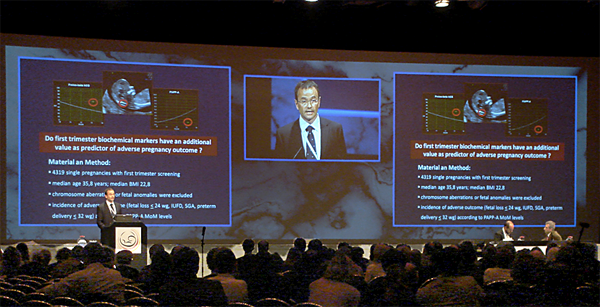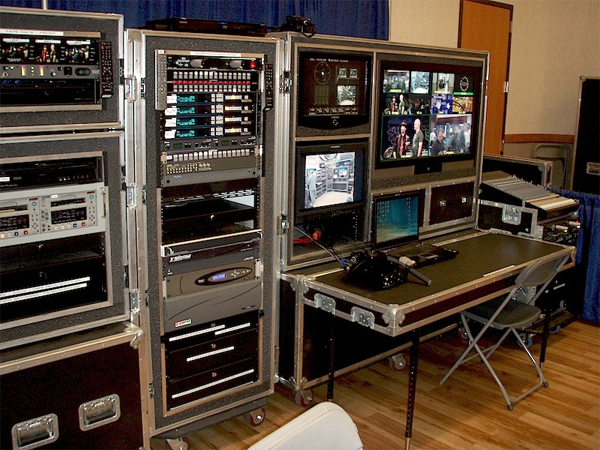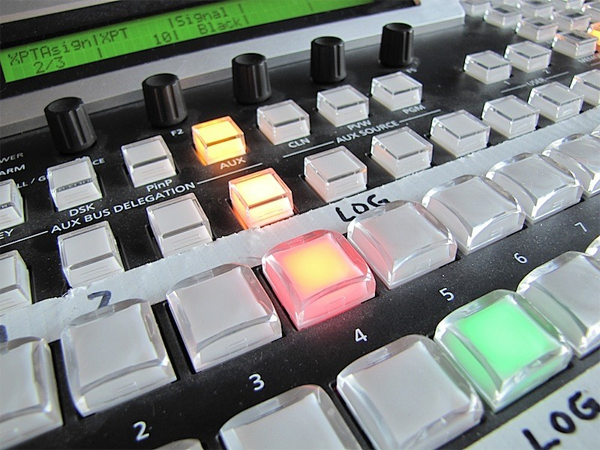What is IMAG?
Streaming Media Producer continues its "What Is...?" series tackling essential topics in the streaming media and live production world with a look at IMAG, or image magnification, a common and effective way of delivering instant video projection of speakers and performers at corporate, conference, and faith-based events. We examine the technical challenges, the required gear, and the preferability of producing separate feeds for projection and streaming of the same event.
Big Screens for IMAG
If you have a 40" Plasma screen next to the stage, or along the walls of the meeting room, it's generally not IMAG; it's more about distributing the feed. If you have two 20' projection screens flanking either side of the stage, it's IMAG. If it's a high-end corporate year-end presentation and you have a 200' wide, 20' tall, seamless backdrop of either LED blocks or seamless projection, it's definitely IMAG.

Huge auditorium IMAG, image © Analog Way
There's all sorts of technology that makes this happen, and specialized hardware can handle anything beyond a single projector and a single screen. These dedicated boxes can handle multiple HD feeds and seemlessly blend multiple inputs, simultaneously, between projectors, or stacks of projectors (for brightness) for what can feel like a completely unlimited canvas.

ULTRAHD, image © Analog Way
However, that level of hardware takes specialized knowledge, so I recommend renting the gear and hiring a subcontractor to operate it at your event.
Separating the Projection and Streaming Feeds
When possible, I also recommend separating the feeds of what is projected and what is recorded/streamed. This requires nearly doubling your control room hardware, but your distant viewers will want to see wide shots, reaction shots, and other angles that help them place the person speaking in context with the room and the audience.

WHD setup
The audience in the room, however, does not want to see themselves on the big screen. When they do, very unfortunate reactions always occur. I speak from experience. People literally try to hide, they are surprised, get mad, or look around the room to try and figure out where the camera is, and none of those reactions relates to the person speaking. All of those reactions detract from you efforts to accurately convey what's happening in the room.

Panasonic AV-HS400N © Anthony Burokas
Some video mixers have the ability to output a second feed to a preview or AUX bus. You can utilize this to provide your in-house IMAG (cuts only) while recording and streaming the main, nicely switched program feed. The Panasonic AV-HS400N is one such video mixer.
If you cannot create two separate feeds, you either need to keep those audience shots to a minimum, or be prepared for the sometimes unintentionally comedic consequences.

Switching, projecting, and recording the TEXO awards at Cowboys Stadium in Dallas
IMAG is the essence of live video. Not just for streaming, which has a diluted response, but to a room full of people whom you reach instantly, and you can hear it. If you haven't already, visit my article, What Is Live Streaming? and especially the video at the end.
Related Articles
Streaming Media Producer kicks off its "What Is...?" series tackling essential topics in the streaming media production world with a look at live switching, touching on the differences between switching and mixing, assembling the components and crew of a live switch, and the basics of "punching" a multi-camera show or event for live delivery.